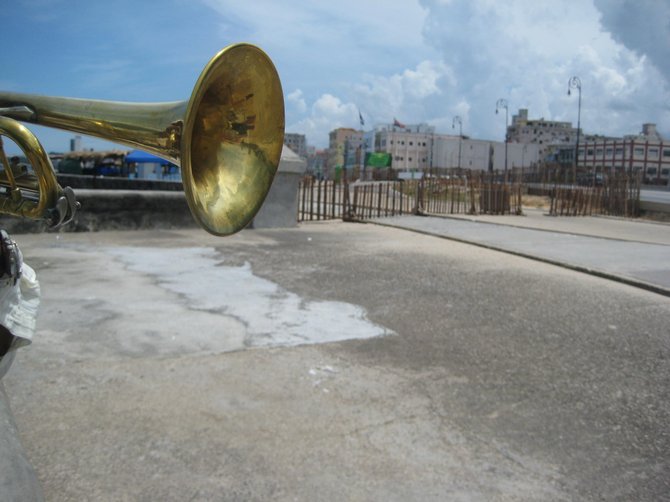 Facebook
Facebook
 X
X
 Instagram
Instagram
 TikTok
TikTok
 Youtube
Youtube

“What are they all waiting for over there?” A group of women are waiting on a neighborhood street corner. The truck is arriving sometime in the day, exact time unknown, to deliver their monthly ration of meat.
A grandmother sits comfortably in her small, bare apartment. She is ecstatic after opening a package stuffed with three pairs of used shoes sent from relatives in the States.
An elderly Cuban woman, shuffling along the sidewalk underneath her parasol, warmly offers directions to the Plaza de la Revolucion (one of the world’s largest city squares, covering approximately 775,000 square feet). The constant question follows, “What is Cuba to you?” She doesn’t answer with what Cuba “is,” but speaks of the U.S. and how health care there is not free. And follows with how she heard that the U.S. unemployment rate is now at 90%. She believes Fidel was much more caring for the Cuban people than his brother, Raul, has been with his cold ways. In parting and without hesitation, she offers all of the pesos she has in her hands in case it’s needed for the bus fare.
A man sitting down on a ledge plays his trumpet. "I love Cuba." He glowingly belts out a few tunes and then explains where to catch an afternoon “son” session (one of the three major Cuban musical genres, along with samba and bolero).
This life is starkly separated from the world that works with the CUC (Convertible Cuban Peso), the currency utilized in and around Cuba’s tourist industry. Reality in Cuba functions with the CUP (Nonconvertible Cuban Peso), the national monetary unit, while being orchestrated by the government’s program.
It’s a community that doesn’t have much in terms of material, but is rich with a love for its country and a reverence for its (ex)leader who seems immortal. But today it’s antiquated – and becoming more so, exponentially, day by day.
Things to Do. Stroll along the Malecon — a concrete boardwalk hugging the city’s rocky ocean shoreline – taking in a plethora of people-watching opportunities. Visit Callejon de Hamel, on Hamel Street between Aramburu and Hospital, to be awakened by some local music on Sunday afternoons. Walk around and ask locals questions. Exchange some CUC for CUP and take a few “taxi rides” from regular cars with a taxi sign posted on the windshield.
Recommendations. Brush up on your Spanish to enter this world more easily. Make sure to exchange your CUP back to dollars or CUC before you get to the airport for your return flight – they do not accept the former currency for exchange. When walking the streets of Havana, have an idea of where the center of town, the Malecon and Old Havana are at all times. Havana is not a dangerous place, but it’s never wise to be wandering around aimlessly as a foreigner.


“What are they all waiting for over there?” A group of women are waiting on a neighborhood street corner. The truck is arriving sometime in the day, exact time unknown, to deliver their monthly ration of meat.
A grandmother sits comfortably in her small, bare apartment. She is ecstatic after opening a package stuffed with three pairs of used shoes sent from relatives in the States.
An elderly Cuban woman, shuffling along the sidewalk underneath her parasol, warmly offers directions to the Plaza de la Revolucion (one of the world’s largest city squares, covering approximately 775,000 square feet). The constant question follows, “What is Cuba to you?” She doesn’t answer with what Cuba “is,” but speaks of the U.S. and how health care there is not free. And follows with how she heard that the U.S. unemployment rate is now at 90%. She believes Fidel was much more caring for the Cuban people than his brother, Raul, has been with his cold ways. In parting and without hesitation, she offers all of the pesos she has in her hands in case it’s needed for the bus fare.
A man sitting down on a ledge plays his trumpet. "I love Cuba." He glowingly belts out a few tunes and then explains where to catch an afternoon “son” session (one of the three major Cuban musical genres, along with samba and bolero).
This life is starkly separated from the world that works with the CUC (Convertible Cuban Peso), the currency utilized in and around Cuba’s tourist industry. Reality in Cuba functions with the CUP (Nonconvertible Cuban Peso), the national monetary unit, while being orchestrated by the government’s program.
It’s a community that doesn’t have much in terms of material, but is rich with a love for its country and a reverence for its (ex)leader who seems immortal. But today it’s antiquated – and becoming more so, exponentially, day by day.
Things to Do. Stroll along the Malecon — a concrete boardwalk hugging the city’s rocky ocean shoreline – taking in a plethora of people-watching opportunities. Visit Callejon de Hamel, on Hamel Street between Aramburu and Hospital, to be awakened by some local music on Sunday afternoons. Walk around and ask locals questions. Exchange some CUC for CUP and take a few “taxi rides” from regular cars with a taxi sign posted on the windshield.
Recommendations. Brush up on your Spanish to enter this world more easily. Make sure to exchange your CUP back to dollars or CUC before you get to the airport for your return flight – they do not accept the former currency for exchange. When walking the streets of Havana, have an idea of where the center of town, the Malecon and Old Havana are at all times. Havana is not a dangerous place, but it’s never wise to be wandering around aimlessly as a foreigner.
Comments